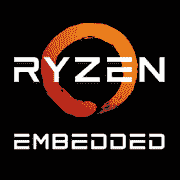AMD Ryzen Embedded V1756B

AMD Ryzen Embedded V1756B: In-Depth Analysis of the Processor for Specialized Solutions
April 2025
1. Key Specifications: Architecture, Process Technology, Performance
Zen Architecture and 14nm Process Technology
The AMD Ryzen Embedded V1756B processor is built on the first generation Zen microarchitecture, released in 2017. Despite utilizing a 14nm process technology (which has become outdated by 2025), the chip remains relevant in the embedded solutions segment due to its optimization for energy efficiency and reliability.
Key Parameters:
- 4 cores / 8 threads (SMT).
- Base Frequency: 3.25 GHz, Boost Frequency: 3.6 GHz.
- L3 Cache: 2 MB (modest for multi-threaded tasks).
- TDP: 45 W.
- Integrated Graphics: Radeon Vega 8 (8 GPU cores, frequency up to 1100 MHz).
Performance in Benchmarks
In Geekbench 6, the processor scores 977 points (single-core) and 3013 (multi-core). This performance level is comparable to desktop CPUs from 2018–2019 (e.g., Ryzen 5 2400G). The Vega 8 can handle 4K video and simple 3D applications, but it is unsuitable for gaming in 2025.
Features:
- Support for ECC memory for corporate tasks.
- Advanced interfaces: USB 3.1, PCIe 3.0, SATA III.
- Long-term supply (up to 10 years) — a key advantage for industrial systems.
2. Compatible Motherboards: Sockets and Chipsets
FP5 Socket and Specialized Boards
The Ryzen Embedded V1756B uses the FP5 socket, designed for compact and industrial solutions. This means standard PC motherboards (AM4, AM5) are not compatible.
Recommended Chipsets:
- AMD X470D4U (ASRock) — a Mini-ITX board with ECC support, IPMI 2.0, and dual 10G LAN ports. Price: ~$200–250.
- ASUS AIMB-228 — model featuring HDMI 2.0, four DDR4 slots, and TPM 2.0. Price: ~$180–220.
Choosing Tips:
- Check for the availability of interfaces: SATA, M.2, COM ports for industrial sensors.
- Ensure support for discrete GPUs via PCIe x8 (relevant for systems with dedicated graphics).
3. Supported Memory: DDR4 and ECC
The processor works only with DDR4 memory (up to 3200 MHz). There is no support for DDR5, which limits performance for tasks sensitive to RAM speed.
Recommendations:
- Optimal volume: 16–32 GB (2 modules of 8–16 GB for dual-channel mode).
- Example modules: Kingston KVR32S22D8/16 (16 GB, DDR4-3200, ECC) — ~$60 each.
Important: Stability is critical for embedded systems — choose memory with ECC and verified compatibility.
4. Power Supply: Calculations Based on TDP and Practice
With a TDP of 45 W, the processor does not require a powerful PSU. However, it is important to consider the power consumption of other components:
- Mini-PC/Media Center: Power supply of 150–200 W (e.g., PicoPSU-160-XT + external adapter).
- Industrial System with Additional Devices: PSU of 300–400 W (e.g., Seasonic SSP-300SUG, 80+ Gold, ~$55).
Advice: For 24/7 operation, choose power supplies with 80+ Platinum/Titanium certification and overload protection.
5. Pros and Cons of AMD Ryzen Embedded V1756B
Advantages:
- Integrated Vega 8 graphics — no need for a discrete graphics card for basic tasks.
- Low power consumption — suitable for passive cooling systems.
- Long-term support — guaranteed stable supply until 2030.
Disadvantages:
- Outdated 14nm process technology — high heat generation under peak loads.
- Limited L3 cache — disadvantage in multi-threaded applications.
- Lack of PCIe 4.0/5.0 — slow data transfer with NVMe SSDs.
6. Use Cases: Where the Potential is Unleashed
Industrial and Commercial Systems
- Manufacturing Line Management: The chip is integrated into Advantech MIC-7500 controllers (~$1200), processing data from sensors in real-time.
- Digital Signage: Support for 4K@60Hz via HDMI 2.0.
Home and Office Tasks
- Media Centers: Streaming 4K video (Plex, Kodi) + light gaming (Stardew Valley, Minecraft).
- Office PCs: Document work, video conferencing, browsing with 20+ tabs.
Not Suitable For:
- Modern gaming (Cyberpunk 2077, GTA VI — FPS below 30 on low settings).
- 3D rendering and neural networks.
7. Comparison with Competitors
Intel Core i5-10500E (14 nm, 6C/12T, UHD Graphics 630)
- Intel Advantages: 6 cores, higher performance in multi-threaded tasks (Geekbench 6 Multi ~3400).
- Intel Disadvantages: UHD 630 graphics is 40% weaker than Vega 8, higher price (~$280).
NXP i.MX 8M Plus (ARM Cortex-A53/A72)
- For IoT: Energy efficiency (TDP 5 W), but x86 compatibility of Ryzen wins in flexibility.
Conclusion: V1756B is a golden mean between performance and specialization.
8. Practical Assembly Tips
1. Cooling: Even with a TDP of 45 W, use Noctua NH-L9a coolers (~$45) or passive heatsinks in closed cases.
2. Storage: Choose M.2 NVMe SSD (e.g., WD Red SN700 500GB, ~$50) for fast OS loading.
3. Drivers: Install the AMD Embedded Driver Pack for stable operation under Linux/Windows IoT.
9. Final Conclusion: Who is V1756B for?
This processor is designed for niche scenarios:
- Industrial system integrators — long lifespan, ECC memory.
- Enthusiasts of compact media centers — Vega 8 graphics, quiet operation.
- Budget office PCs — low total cost of ownership (~$250 for CPU + $180 for the board).
Why not a gaming PC? Outdated architecture and graphics do not meet the demands of 2025. However, for embedded tasks, it is one of the best options on the market.
Prices are current as of April 2025.
Basic
CPU Specifications
Memory Specifications
GPU Specifications
Benchmarks
Compared to Other CPU
Share in social media
Or Link To Us
<a href="https://cputronic.com/en/cpu/amd-ryzen-embedded-v1756b" target="_blank">AMD Ryzen Embedded V1756B</a>